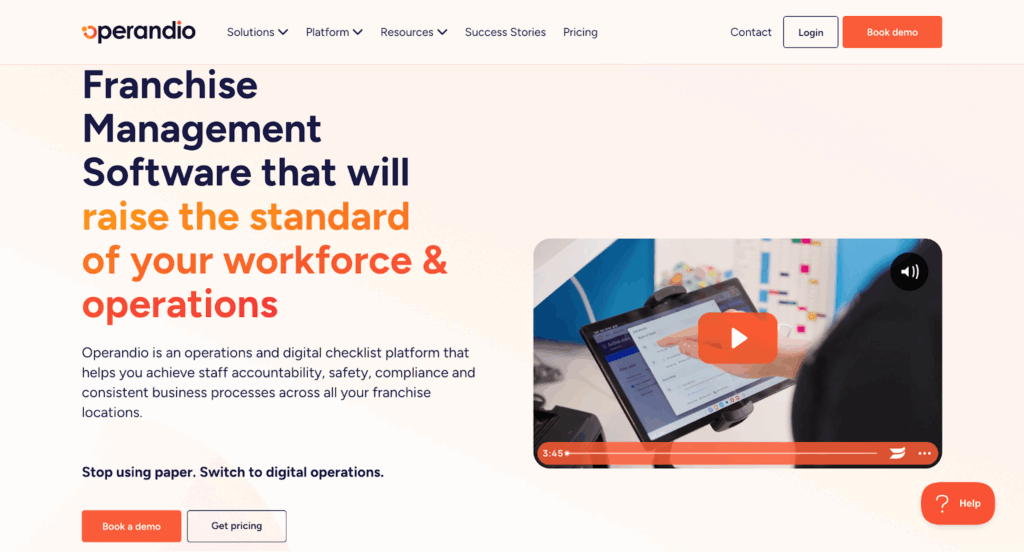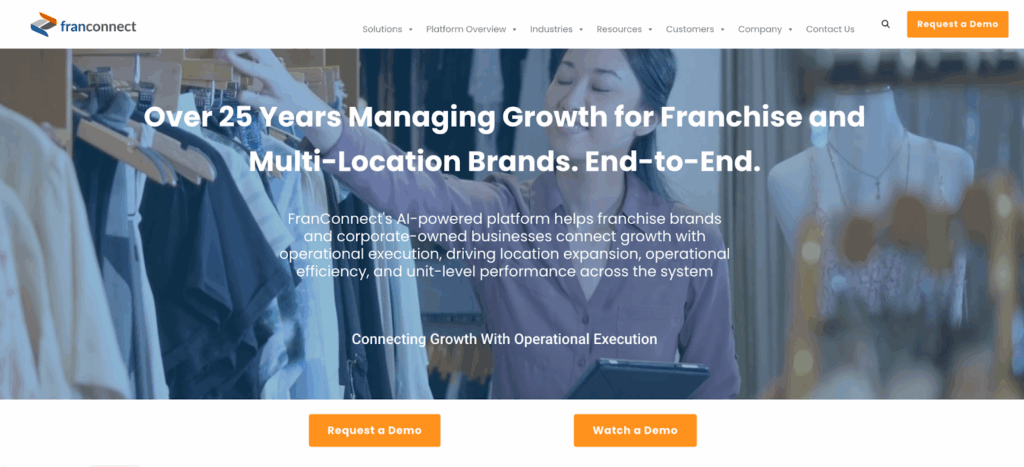Franchise Expansion: How to Grow Your Franchise in 2025
Key Takeaways:
- Make sure your current operations are solid by documenting your SOPs, ensuring consistent performance across every location, and building systems that can scale as you grow.
- Franchises that scale successfully invest in training, communication, and ongoing support for their employees — not just increasing unit count.
- Scale with structure, not stress. Operandio gives growing franchises the digital systems to support every location, maintain daily operations, and keep performance on track as the network grows.
You’ve proven the concept. The first few locations are running smoothly, franchisees are seeing returns, and your brand is starting to build real momentum.
Now comes the hard part: How to grow your franchise to the next level, without losing control.
In this guide, you’ll learn how to expand your franchise the right way — by putting systems in place that keep your operations consistent, your teams aligned, and your standards high.
Let’s look at how to grow your network, without losing visibility, wasting time, or stretching your team too thin.
What Is Franchise Expansion?
Franchise expansion is the strategic process of growing your franchise network through carefully selected new locations and markets.
But true expansion differs from simply adding units. It’s about having a strategic market penetration that strengthens your brand.
Think of it this way. You can add 20 locations in random cities and technically call it growth. Or you can select markets where your concept thrives, support franchisees properly, and build infrastructure that maintains brand consistency.
The second approach creates sustainable expansion that compounds over time.
Whether you’re exploring domestic markets or considering international franchise expansion, the goal remains the same: extend your brand reach while maintaining operational control.
When done right, expansion transforms your franchise from a collection of separate locations into a robust network. And that’s where fragmented systems can either make or break your growth trajectory.
Key Steps to Expand a Franchise Successfully
Step #1: Assess Your Expansion Readiness
Before you bring on new franchisees, get real about your current operations. Are your systems clear, consistent, and repeatable? If not, expansion will only multiply your problems.
Document everything — daily routines, checklists, escalation plans. You can’t scale what you haven’t systemized.
Step #2: Create Franchisee Support Systems
Your franchise needs ongoing support to succeed, structured training, clear communication, and accessible resources when challenges come up.
Build your support systems early. Solid franchise onboarding process, clear escalation paths, and consistent check-ins turn new franchisees into confident operators.
Without that structure, even strong franchisees can falter and won’t stay long.
Step #3: Maintain a Standard Operation Across All Locations
Your customers should receive the same experience whether they visit your location in Portland or Phoenix. That level of consistency requires a standard operating procedure document that everyone follows.
Document your processes in detail, then make them accessible through centralized task management systems.
When every location follows the same playbook, you remove the guesswork, lighten the load on franchisees, and build efficiency that scales.
Without that structure, each site ends up making it up as they go, and that’s where things fall apart.
Step #4: Implement Real-Time Visibility Tools
You can’t manage what you can’t see. As your franchise grows, maintaining oversight becomes exponentially harder without the right technology.
This is where operations dashboards become non-negotiable for expansion.
Real-time visibility lets you catch issues early, spot high and low performers, and track task completion and compliance, all from one place.
It keeps you connected to day-to-day operations without getting buried in them.
Common Challenges in Franchise Expansion
Challenge #1: Communication Breaks Down Across Locations
As your franchise grows, employee communication begins to get complex. The resultant effect of this can stunt growth, as essential updates go unread, policy changes don’t reach the floor, or employees receiving time-sensitive messages arrive too late.
This communication gap creates real operational consequences. Locations miss deadlines, execute outdated procedures, or operate with incomplete information.
The result? Brand inconsistency and franchisee frustration. Employee communication apps solve this by creating direct channels that ensure messages reach every team member, every time.
Challenge #2: Brand Standards Drift Over Time
As your network grows, brand consistency starts to slip. A menu tweak here, a service shortcut there — and suddenly, the experience feels different from one location to the next.
This drift happens gradually, which makes it dangerous. Customers notice when their experience varies wildly by location, and they remember.
Protecting brand consistency requires constant vigilance through regular franchise audits and keeping a standard checklist that keeps everyone aligned to your core standards.
Challenge #3: Compliance Becomes Overwhelming
Every new location adds more compliance requirements, from health codes to labor laws and safety checks. Manual tracking falls apart quickly, and the consequences for missing something are serious.
When you manage multiple restaurants or franchise locations, compliance complexity multiplies exponentially. One missed requirement can trigger fines, legal issues, or worse.
Digital systems that automate compliance tracking and create audit trails protect you from these risks while reducing administrative burden.
Challenge #4: Operational Visibility Disappears
In a single location, you see everything. At five locations, you stay reasonably informed.
But at 20, 50, or 100 locations? Visibility evaporates unless you have the proper infrastructure. You’re flying blind, making decisions based on incomplete data or outdated information.
This invisibility creates dangerous blind spots. Problems fester unnoticed.
Top performers go unrecognized. Resources get allocated inefficiently. The solution requires operational visibility tools that aggregate data across your network and surface insights that drive better decisions.
Best Tools for Scalable Franchise Expansion
Operandio: The All-in-One Franchise Growth Platform

If you need a platform that handles every aspect of franchise operations in one place, then you need Operandio.
Operandio gives you the infrastructure to manage communication, maintain standard operations, train franchisees, track compliance, and monitor performance — all from a unified dashboard.
No more juggling five different tools or losing critical information in disconnected systems.
Here’s what makes Operandio essential for expansion:
- Connects your head office with every location through streamlined workflows and real-time data.
- Pushes updates instantly across your network with the employee communication hub.
- Tracks task completion with smart, mobile-friendly checklists.
- Speeds up onboarding with a built-in learning management system.
- Delivers real-time visibility through operational reporting dashboards.
- Keeps teams aligned to your standards, no micromanaging required, with its task management feature.
Operandio provides the systems that scale. It transforms chaotic expansion into controlled growth, allowing you to add locations confidently while maintaining the quality that built your brand.
FranConnect: CRM and Lead Management

FranConnect specializes in franchise development and sales. The platform helps you track prospective franchisees, manage the sales pipeline, and coordinate the onboarding process.
If your expansion strategy focuses heavily on recruitment and franchisee acquisition, FranConnect provides solid tools for those early-stage activities.
If you’re still exploring your options, here’s a helpful guide to FranConnect alternatives and competitors
ServiceM8: Field Service Management

For franchises that deliver services at customer locations, ServiceM8 offers job scheduling, dispatch, and invoicing capabilities.
It works particularly well for home services franchises where technicians need route optimization and mobile access to customer information. The tool helps coordinate field operations across multiple territories.
Trainual: Process Documentation

Trainual focuses specifically on documenting procedures and training. The platform creates searchable process libraries that new franchisees can reference.
While it doesn’t handle operations management or real-time communication, it serves as a valuable complement for franchises that need to build comprehensive employee training software libraries.
How to Measure Franchise Expansion Success
Metric #1: Unit Growth Rate
The most obvious expansion metric tracks how quickly you add new locations. But raw growth numbers tell only part of the story. What matters more is sustainable unit growth—expansion that maintains profitability and brand standards while increasing your footprint.
Calculate your growth rate by tracking new units opened versus planned openings. Are you hitting your expansion targets on schedule? More importantly, are these new locations performing to your standards? A slower growth rate with higher-quality units beats rapid expansion with struggling franchisees every time.
Metric #2: Franchisee Satisfaction
Your franchisees vote with their feet. High satisfaction means renewals, additional unit purchases, and positive word-of-mouth that attracts quality candidates. Low satisfaction creates turnover, legal disputes, and reputation damage that kills expansion.
Monitor employee performance and satisfaction through regular surveys, renewal rates, and open feedback channels. Track key indicators like time-to-profitability, support request volume, and franchisee retention. When franchisees thrive and recommend your system to others, you’ve built something sustainable.
Metric #3: Profitability and ROI
Growth without profitability is just expensive noise. Track both franchisee-level ROI and franchisor-level returns. Are new locations hitting projected revenue? How long until they break even? What’s the total cost of expansion versus the return it generates?
Use restaurant analytics and reporting to monitor financial health across your network. Compare performance by market, franchisee, and vintage. This data reveals which expansion strategies work and which drain resources without adequate return.
Metric #4: Operational Compliance Rate
Compliance metrics show whether your standards travel as you grow—track completion rates for required tasks, audit scores, and adherence to brand guidelines. High compliance means your systems work and franchisees execute your concept correctly.
Operational reporting software makes compliance measurement automatic rather than manual. You see real-time compliance rates, identify locations that need support, and catch deviations before they become problems. This visibility keeps quality high as quantity increases.
Scale Your Franchise Network With Confidence With Operandio
The franchises that scale successfully share one thing: they build infrastructure before they need it. They create support systems that empower franchisees, implement technology that maintains visibility, and establish standards that travel across locations. This foundation transforms expansion from a risky gamble into a predictable process.
Operandio gives you that foundation. It connects every part of your franchise operation — from headquarters to the newest location — through one powerful platform. No more disconnected tools. No more information gaps. No more wondering what’s really happening across your network.
Ready to scale with confidence? Discover why franchises choose Operandio to power their growth and see how the right platform transforms expansion from overwhelming to achievable.


